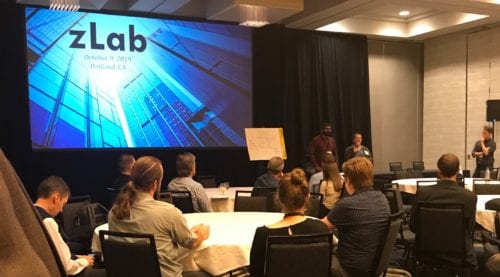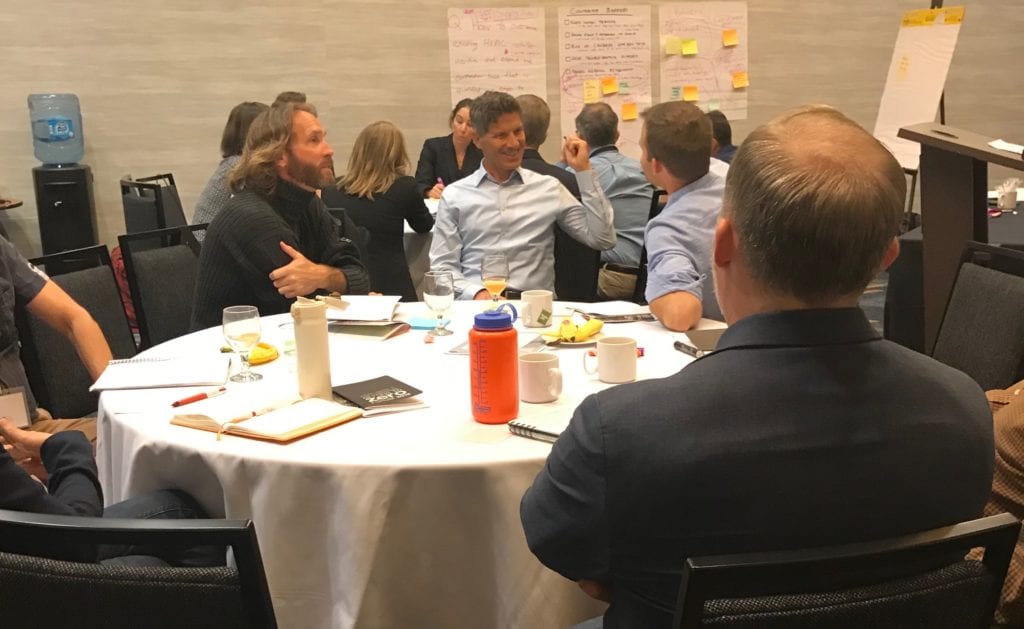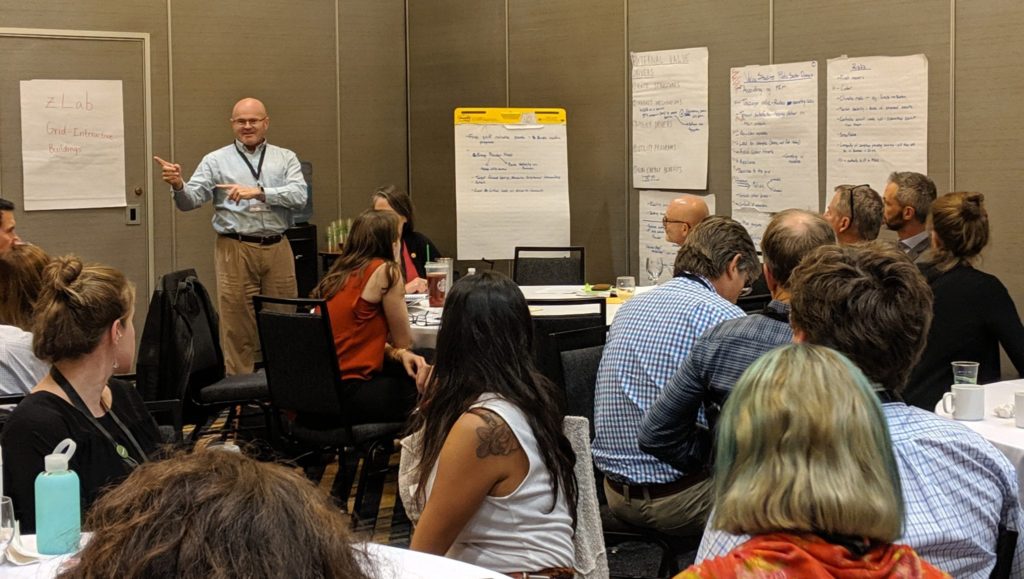
Defining the Future of the Built Environment
Today, buildings account for nearly 40 percent of greenhouse gas emissions. Thus, transforming the building stock is essential to ensure a decarbonized energy system and to keep global temperature rise below 2°C. That’s what nearly 600 leading policymakers, design professionals, building owners, and systems manufacturers were discussing at the Getting to Zero Forum in Oakland, California, last week.
This year at the forum (as California’s largest utility cut off power to more than 800,000 customers), Rocky Mountain Institute (RMI) and the New Buildings Institute launched an inaugural event, zLab, that brought together a select group of industry leaders to tackle market barriers, brainstorm solutions, and develop action plans to cost-effectively accelerate the transition to a zero-carbon future. The zLab participants divided up into three groups for half-day sessions focused on building electrification, grid-integrated buildings, and advanced building policy.
While it is impossible to capture the outcomes of the zLab sessions in a single blog post, here is a snapshot of the results.
Building Electrification for Decarbonization
More than 70 million US homes and businesses burn natural gas, oil, or propane on-site, generating almost 14 percent of the country’s greenhouse gas emissions (not including methane leaks). Thus, building electrification is a key strategy for decarbonization. This zLab group focused on three critical issues:
- Getting consumers to demand electric heat pumps and stoves from their contractors
- Expanding contractor capacity to deliver electrification solutions
- Making low-power solutions available and “retrofit-ready”
After addressing the barriers to each issue, the group came up with five basic solution sets to tackle the three issues:
- Work with health professionals and institutes to inform people about health benefits
To increase consumer demand for all-electric homes, the group focused on gas stoves as a key barrier and an entry point for raising awareness about the benefits of electrification. Gas stoves present an immediate health threat for people with asthma or other respiratory concerns. Many people aren’t aware of the health dangers of cooking with gas. By working to inform air pollution agencies, health providers, low-income housing agencies, insurance companies, hospitals, and environmental justice organizations of these dangers, they can help reach the people most at risk via trusted sources of information. - Lower costs with a rate-based design
A contractor would install a high-efficiency heat pump with demand response capability in a home. The utility company would pay for a basic heat pump and would bill the customer a rate-based payment. The customer would have the option of paying an incremental cost for a higher-efficiency heat pump. Thus, the customer gets the heat pump for a lower cost and has lower monthly bill payments. This would also position the utility to further offset costs with carbon credits, health credits, or other ways to support this package. This might not be a permanent rate, but could last a specific amount of time (e.g., 10 years) and then ramp down. - Develop low-power specifications for utilities and manufacturers
It is crucial to develop specifications for electric appliances that are low-power, retrofit-ready, and would not require a house to invest in an electrical panel upgrade. Then utility companies and manufacturers can develop and/or import these appliances. The group developed basic specifications for electric panels, water heaters, stoves, and fireplaces/firepits. - Increase contractor capacity through workforce development
Contractor capacity can be increased through standardized trainings by integrating electrification skills into existing relevant workforce training. This electrification focus could include trainings for heat pump installations and create industry apprenticeships and training materials. The group also felt that HVAC tradespeople might benefit from a rebranding, perhaps as “clean energy technicians” or something similar, to draw more people into the field and refocus the emphasis of their work onto electrification. - Offer contractor incentives
Utilities and manufacturers can create funding sources for contractors prioritizing heat pumps. Contractor incentives could include training incentives (e.g., the contractor could be a government-preferred contractor after having gone through the training) and performance-based incentives (the cost of the training could be refunded after selling a certain number of units).
Unlocking New Value Through Grid Integration
Grid-interactive buildings are intelligent, responsive buildings that interact with the grid and can deliver new opportunities to save costs for building owners, occupants, and utilities. As responsive assets, grid-interactive buildings can ramp energy use up or down depending on the cost or carbon intensity of the utility generation source.
Aiming for a goal of 50 percent of the US building stock being grid-integrated in the next five years, this zLab group explored the perspective of different stakeholders—public, private, multifamily building owners, and commercial developers—to outline how to unlock new economic value and incentivize investments.
Public Portfolio Owners
Many owners of public buildings are risk averse. Add to that the inherent need to keep costs low while ensuring high tenant satisfaction, and successful management of publicly owned buildings becomes a tightrope act. Grid-interactive buildings are appealing due to the large amount of savings that can be realized. For example, a recent RMI report details how the largest landlord in the United States, the General Services Administration, could unlock $50 million in annual cost savings—approximately 30 percent cost savings on a per-project basis—and $70 million in value to grid users by incorporating grid-integrated efficient buildings into its portfolio.
Private Corporate Owners
Private corporate owners are not in the business of managing their buildings’ energy use; profitably running their companies is priority number one. However, savvy owners understand that building performance is closely tied to employee productivity and satisfaction—and keeping employee turnover low is critical in a competitive job market. A grid-integrated program offers a way to keep costs low while optimizing performance, ensuring resilience, and bolstering brand.
Commercial Developers
Developers of commercial buildings are looking for three things when evaluating build-out: to maximize profit, to ensure tenants are “sticky,” and long-term resiliency. As more developers explore net-zero buildings and grid integration, some are discovering an enormous gain in all three. For example, a northern California developer spent $1.6 million to retrofit one of his buildings to be net-zero energy, and within five years realized $6 million in value. How? By nearly eliminating the energy bill for the tenant (a manufacturer) he could raise the yearly rent while still ensuring a very sticky tenant that can tout adherence to sustainability in its brand, a huge competitive advantage in the market.
Multifamily Building Owners
With no roadmap for creating a grid-integrated building, owners of multifamily buildings are faced with two primary challenges: split incentives between tenants and owner, and a lack of technologies and options from manufacturers and the utility. Like corporate owners and commercial developers, multifamily building owners are keen to also keep tenants, but most residential renters are not focused on energy when they sign a lease.
The group coalesced around several solutions including:
- Raising awareness about the risks and market opportunities for grid-interactive buildings that would lead to an understanding of how to value decarbonization
- To reduce the hassle factor and complexity for all flavors of building owners, the market needs to offer new energy-as-a-service programs. This would require an intermediary—beyond distributed energy resource aggregators and energy service companies—that would work with both the day-to-day operations of the building and the utility, saving owners money and avoiding carbon.
- Rate structure changes to incent behavior and increase the speed of change
- Advanced technologies that would ease implementation
- New policies that advance behavior change and open new markets
Advanced Decarbonization Policies for Existing Buildings
The third zLab group consisted largely of city policymakers—many representing cities participating in the American Cities Climate Challenge—working to develop solutions to accelerate broader adoption of performance standards for existing buildings. In order to achieve long-term emissions targets, substantial reductions are needed from the existing commercial and residential building stock. In contrast to new construction, policies to require building efficiency and electrification retrofits have been rare to date but are becoming increasingly critical to drive progress at the pace and scale needed.
After hearing firsthand about successful policy development and implementation considerations from Washington state; Washington, D.C.; and Los Angeles, the group of cities and policy-expert partners jointly identified high-priority barriers and developed solutions within four core focus areas:
- Measurements and metrics
One of the more challenging elements of designing these policies is setting appropriate performance thresholds for a range of building types, including selecting the most relevant metrics (whether energy- and/or carbon-based), determining pathways for owners to comply, and ensuring adequate data to measure and track performance over time. Solutions put forth by the group included leveraging benchmarking policies and data, designing prescriptive pathways for smaller buildings, customizing compliance to specific use types, and collaborating with utilities to unlock data access.
- Equity and workforce development
There is a need to ensure that performance requirements are not overly burdensome for owners and that costs are not unfairly passed on to tenants (particularly in affordable and multifamily housing), to design policy with low-to-moderate income considerations in mind, and to develop, train, and diversify the workforce. Solution concepts involved strategies such as proactively reaching out to impacted communities through trusted conveners, creating a technical assistance resource center, and developing stronger partnerships between cities/sustainability offices and labor unions (including by solidifying a value proposition for labor that is more attractive than the one currently offered by the fossil fuel industry).
- Incentives and triggers
Policymakers must align with incentives and financing options to reduce friction and market resistance, and ensure that requirements are phased in in a manageable way. Solutions included conducting pilot projects to inform policy development (particularly around expected costs) and guide implementation, educating both consumers and the real estate sector using simplified nontechnical messaging, engaging with utilities to shape and secure incentives that are most appropriate for the work expected, and recognizing early adopters.
- Stakeholder engagement
Key challenges under this topic included equitably identifying stakeholder groups that need support and engagement the most, developing core messaging, and tailoring the engagement process to resonate with stakeholders and follow through on equitable policy design. To address these, the group proposed several strategies including leveraging data analysis to determine which stakeholders cause the biggest impacts and are the most impacted, developing value propositions specific to different audiences and keeping messaging simple, and putting adequate financial and other resources into the design and execution of the stakeholder engagement process to ensure broad and diverse coverage with trained facilitation.
What’s Next?
After zLab, the results were reported out to the entire Getting to Zero Forum, and participants were invited to add their ideas, feedback, and the commitments they were going to make to drive the building revolution forward. We will also be providing more in-depth reports on each of the three zLab sessions. The next Getting to Zero Forum will be held in March of 2021 in New York City, where we will discuss the actions that were taken, the impacts of those actions, and how we can do even more to accelerate the transition to a zero-carbon future.

